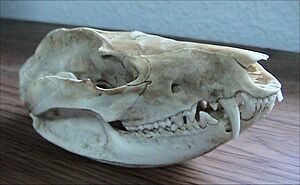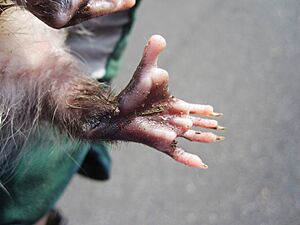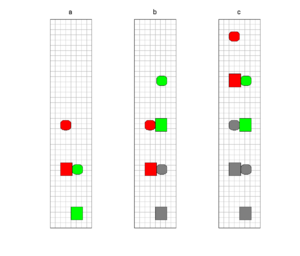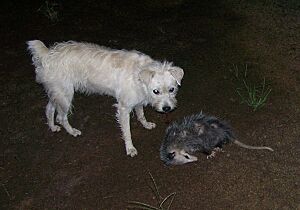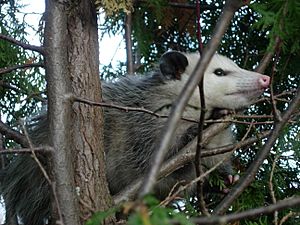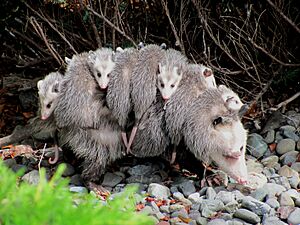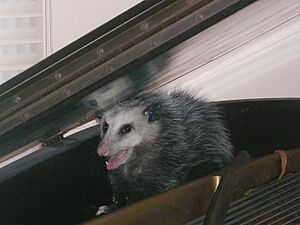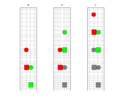Virginia opossum facts for kids
Quick facts for kids Virginia opossum |
|
|---|---|
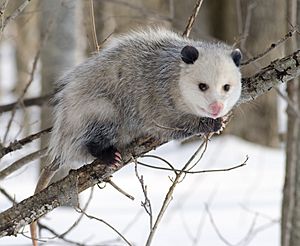 |
|
| North American opossum in winter | |
| Conservation status | |
| Scientific classification | |
| Genus: |
Didelphis
|
| Species: |
virginiana
|
 |
|
| Range of habitat, showing both historic, native range and introductions in the west; these areas are currently expanding northward (e.g., into Wisconsin and Minnesota). | |
| Synonyms | |
|
Didelphis marsupialis virginiana |
|
The Virginia opossum (Didelphis virginiana) is also called the North American opossum. It is the only opossum that lives north of Mexico. Its home range stretches all the way into Central America. This makes it the northernmost marsupial in the world. In the United States and Canada, people often just call it a "possum". It is a nighttime animal that lives alone. It's about the size of a house cat. Opossums are very good at finding food and places to live.
Many people in North America know opossums. They often live near towns where they can find food. This includes places like trash cans, pet food bowls, and gardens. Because they move slowly at night and are drawn to food on roadsides, they are sometimes seen near busy roads.
Contents
What's in a Name?
The Virginia opossum was the first animal to be called an "opossum". This word comes from an old Algonquian word, wapathemwa. It means "white animal". People often just say "possum" for short. The name opossum is also used for other marsupials in the families Didelphidae and Caenolestidae. The scientific name Didelphis comes from Ancient Greek. It means "two wombs".
The possums that live in Australia are also marsupials. They got their name because they look a bit like the opossums in the Americas. However, they belong to a different group of animals.
In Mexico, the Virginia opossum is known by names like tlacuache or tacuachi. These names come from the Nahuatl word tlacuatzin.
Where Do Opossums Live?
The ancestors of the Virginia opossum first lived in South America. They moved into North America about 3 million years ago. This happened during a time called the Great American Interchange. It was when a land bridge, the Isthmus of Panama, formed. The Didelphis group came to North America about 800,000 years ago.
Today, you can find opossums from Costa Rica in Central America all the way up to southern Ontario in Canada. They are spreading their range northward quite quickly.
Before European settlers arrived, opossums lived as far north as Maryland. They were also found in southern Ohio, Indiana, Illinois, Missouri, and Kansas. As settlers cleared dense forests, opossums were able to move further north. Also, their main predators in these areas became fewer. This helped opossums spread even more.
Since 1900, their range has grown a lot. They now live in most of New England, including Maine. They are also in New York, parts of Quebec, and much of southern and eastern Ontario. You can find them in most of Michigan, Wisconsin, and Minnesota. They are also in southeastern South Dakota and most of Nebraska.
Places like Rhode Island and parts of southern Ontario rarely saw opossums in the 1960s. Now, they are common. Some people think this is because winters are becoming warmer due to global warming. Others believe opossums might have traveled north by accident. They could have climbed onto trucks or trains that crossed rivers like the St. Lawrence or Niagara. Opossums are not used to very cold winters or deep snow. So, if a very cold winter hits a northern area, their numbers might drop a lot.
The Virginia opossum was not originally from the West Coast of the United States. It was brought there on purpose during the Great Depression. People likely used them as a source of food. Now, they live in much of the Pacific coast. Their range is still growing northward into British Columbia, Canada.
Physical Description
Virginia opossums can be different sizes. Those living in the northern parts of their range are usually larger. Those in warmer, tropical areas are smaller. They measure about 33 to 55 centimeters (13 to 22 inches) long from their nose to the start of their tail. Their tail adds another 25 to 54 centimeters (10 to 21 inches).
Male opossums are a bit bigger than females. Males average about 40.8 cm (16 inches) long with a 29.4 cm (11.6 inches) tail. Females are about 40.6 cm (16 inches) long with a 28.1 cm (11.1 inches) tail. Males usually weigh between 2.1 and 2.8 kilograms (4.6–6.2 pounds). Females weigh about 1.9 to 2.1 kilograms (4.2–4.6 pounds).
Their fur is a dull grayish-brown color. Their faces are white. Opossums have long, hairless tails that can grip things. They use their tails to hold onto branches or carry small items. They also have hairless ears and a long, flat nose. Opossums have 50 teeth. This is more than any other land mammal in North America! They also have thumbs on their back feet that can grip, just like our thumbs. These thumbs do not have claws. Female opossums have 13 nipples. Twelve are in a circle, and one is in the middle.
Even though they are very common and successful, Virginia opossums have small brains for their body size. Their brain is about one-fifth the size of a raccoon's brain.
Opossum Tracks
Virginia opossum tracks usually show five finger-like toes on both their front and back feet. The back foot tracks are special because of the opossum's gripping "thumb". This thumb usually prints at a wide angle to the other toes.
Adult opossum front tracks are about 4.8 cm (1.9 inches) long and 5.1 cm (2.0 inches) wide. Their back tracks are about 6.4 cm (2.5 inches) long and 5.7 cm (2.3 inches) wide. Opossums have claws on all their fingers and toes, except for their two thumbs. These claw marks often show up in their tracks.
The tracks in the photo were made when the opossum was walking. This is called a "pacing gait". In a pacing gait, the legs on one side of the body move at the same time. Then, the legs on the other side move. This is why the left-front and right-back tracks are often found together. Other animals that walk this way include raccoons, bears, skunks, and beavers.
When an opossum is pacing, its "stride" (the distance between steps) is usually 18 to 25 cm (7 to 10 inches). By carefully measuring the stride and track size, you can often figure out what animal made the tracks.
Behavior
Playing Possum
If an opossum feels threatened, it will either run away or try to scare off the danger. To look scary, an opossum will show its 50 teeth. It will also snap its jaw, hiss, drool, and make its fur stand up to look bigger.
If this doesn't work, the Virginia opossum is famous for pretending to be dead. This is called "playing possum". It means acting like you are dead or hurt to fool someone.
When playing possum, the opossum lies still on its side. Its mouth and eyes are open, and its tongue hangs out. Its feet are clenched. When very scared, an opossum can also release a green, bad-smelling liquid from its body. This helps to scare away predators. Its heart rate slows down by half, and its breathing becomes so shallow it's hard to notice. This "playing dead" usually stops when the danger goes away. It can last for several hours. This trick helps scare away animals that only eat live prey. It also makes some larger animals think the opossum is not a threat to their babies. Sadly, playing possum when faced with cars often leads to the opossum getting hurt.
Diet
Opossums are omnivores. This means they eat both plants and animals. They eat many kinds of plant foods. They also eat small animals like insects, carrion (dead animals), eggs, fish, and small mammals.
Insects like grasshoppers, crickets, and beetles are a big part of their animal diet. Some studies suggest that opossums eat a lot of ticks they find. They might eat thousands of ticks in a season. This could help stop the spread of diseases carried by ticks, like Lyme disease. However, other studies looking at what wild opossums eat have not found ticks in their stomachs.
Small animals they eat include young rabbits, mice, rats, birds, snakes, frogs, and earthworms. The Virginia opossum is very good at resisting snake venom. Opossums are often attracted to dead animals on the side of the road. This makes them more likely to be hit by cars.
They mostly eat plant foods in late summer, autumn, and early winter. These foods include berries, apples, acorns, seeds, and vegetables. Persimmons are a favorite food in the autumn. Opossums in cities often find food from bird feeders, gardens, compost piles, and garbage cans. They also eat pet food left outside.
Seasonality
The Virginia opossum is most active during spring and summer. It does not hibernate in winter. However, it does slow down its activity when it's cold. It might stay in its den for several days if the temperature drops below -7 to -4 degrees Celsius (19 to 25 degrees Fahrenheit).
Both male and female opossums are more likely to get hurt during breeding season. Males travel further to find mates. This puts them at higher risk from cars and predators because they are in new places. Females carrying babies move slower. They also have to look for food earlier in the evening and later at night. This also increases their risk of getting hurt by cars or predators.
Reproduction and Life Cycle
The breeding season for Virginia opossums can start as early as December. It can last through October. Most babies are born between February and June. A female opossum can have one to three litters of babies each year. During mating season, the male makes clicking sounds to attract the female.
An average litter has 8 to 9 babies. However, more than 20 babies can be born at once! Sadly, many young opossums do not survive. Only about one out of ten babies lives long enough to have their own babies.
Newborn opossums are tiny, about the size of a honeybee. After they are born, the tiny babies climb into the mother opossum's pouch. There, they attach to one of her 13 teats. The young stay attached for two months. They stay in the pouch for about two and a half months. After that, the young climb onto their mother's back. She carries them there for the rest of their time together. During this time, the young learn how to survive. They leave their mother when they are about four or five months old.
Lifespan
Compared to many other mammals, opossums have a very short lifespan. In the wild, a Virginia opossum usually lives only about two years. Even in zoos, opossums only live about four years. Scientists think this short life might be because opossums have few ways to defend themselves from predators. Since they might not live long anyway, they haven't developed ways to live for many years.
One interesting example is a group of opossums on Sapelo Island in Georgia. This island is about 8 kilometers (5 miles) off the coast. These opossums have lived there for thousands of years without natural predators. Scientists found that these island opossums lived up to 50% longer than opossums on the mainland. This supports the idea that predators affect how long opossums live.
Opossums and Humans
Opossums are generally not considered dangerous to humans. When they open their mouths and hiss, it might look scary. But this is often mistaken for signs of rabies. Opossums are naturally resistant to rabies because their body temperature is lower than most mammals. However, opossums can carry parasites and diseases like tuberculosis.
Like raccoons, opossums can be found in cities. There, they eat pet food, old fruit, and human garbage. They are also known to eat chickens on farms in North America. Studies suggest that opossums living near cities tend to be larger. Even though they are sometimes mistaken for rats, opossums are not related to rodents.
The opossum was once a popular animal to hunt for food in the United States. This was especially true in the southern states. There are many old recipes and stories about opossums. For example, old cookbooks like The Joy of Cooking had recipes for opossum. A traditional way to cook it was by baking it, sometimes in a pie. Today, "possum pie" usually means a sweet dessert with no meat at all.
Around the early 1900s, the opossum was in many songs. One famous minstrel song from 1875 was "Carve dat Possum".
Even though they live all over the United States, the Virginia opossum is strongly linked to the American Southeast in stories and culture. In cartoons, they are often used to show characters from the countryside. For example, the Virginia opossum appeared in several episodes of the TV show The Beverly Hillbillies. The main character in Walt Kelly's comic strip Pogo was an opossum.
In 2010, a cross-eyed Virginia opossum named Heidi became famous around the world. She lived in a zoo in Germany. She even appeared on a TV talk show to predict the winners of the 2011 Oscars!
The Perelman Building in Philadelphia, Pennsylvania, has sculptures of animals on its outside. These animals represent different ideas about insurance. One of them is an opossum, which stands for "protection."
Images for kids
See also
 In Spanish: Zarigüeya norteamericana para niños
In Spanish: Zarigüeya norteamericana para niños




